Fishguard is a well known town in North Pembrokeshire, and with its fine harbour is the gateway to Ireland from South Wales. The main place of remembrance for the fallen of both World Wars at Fishguard is the Town Cenotaph, which is located in a small Garden of Remembrance on West Street, Fishguard. There is however an older memorial, which is located within St. Mary’s Church and takes the form of the Rood Screen. In the Churchyard is a memorial to David Sambrook, who was killed in the Boer War, and to local heroine, Jemima Nicholas who, in 1797, famously led the ‘army’ of women in Welsh clothes which the invading French troops took to be redcoats.
Jemima Nicholas
Jemima Nicholas was born at Fishguard in 1750. When the French launched their last attempt at invading Britain in February 1797, they landed troops at Fishguard under the command of the American Colonel William Tate. The invasion was brought to an end after the intervention of the Pembroke Yeomanry, but legend has it that local women, dressed in their traditional red and black clothing and shawls, lined up on the clifftop overlooking the landing site of the French, and were mistaken for Redcoats (British soldiers). Jemima became a local heroine after single-handedly rounding up a dozen drunk French soldiers, and marching them to the Royal Oak pub, where they surrendered. Jemima died in 1832,aged 82, and is buried in St. Mary’s Churchyard.
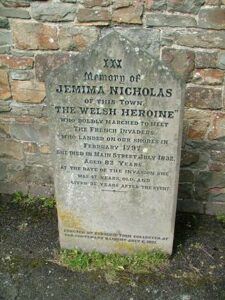
St. Mary’s Church War Memorial, Boer War 1899-1902
David James Sambrook, Colour Sergeant, Welsh Regiment (41st Foot). David was born at Fishguard on 8 October 1871, the son of Ann Sambrook. He served in the Boer War with the 41st Foor, Welsh Regiment. David died of wounds received at the Battle of Driefontein on 10 March 1900. There is a memorial to him in the Churchyard of St. Mary’s Church, Fishguard.
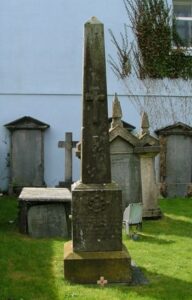
The Great War, 1914-1918
George Batin, Private, 22841, King’s Shropshire Light Infantry. George was born at Fishguard, the son of Thomas and Lettice Batin, later of Trewrach, Dinas Cross. He enlisted at Fishguard into the 1st Battalion, King’s Shropshire Light Infantry, which was attached to 16 Brigade, 6th Division. The Division was in Ireland at the outbreak of War, and was shipped to France, landing at St. Nazaire on 10 September 1914. The BEF was still fighting the desperate rearguard action on the Aisne, and so the 6th Division was rushed to support them there, before moving North to Flanders. They next fought at Hooge, before being brought South to the Somme. By now, due to the tremendous amount of casualties, George had been attached to the 2nd Battalion, Welsh Regiment, in the 1st Division, and they were in the thick of the fighting, fighting at Pozières, when George was mortally wounded. He was brought back to the Casualty Clearing Station at Albert, but Died of Wounds on 27 July 1916, aged 31. He is buried in Albert Communal Cemetery Extension, France. His brother Griffith also fell.
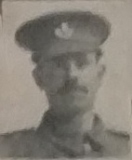
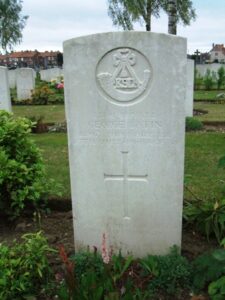
Griffith Batin, Ordinary Seaman, J/52871, Royal Navy. Griffith was born at Fishguard, the son of Thomas and Lettice Batin, later of Trewrach, Dinas Cross. He enlisted into the Royal Navy, serving aboard H.M.S. Mersey. She was a ‘Humber Class’ Monitor, used as an offshore gun battery by the Royal Navy, especially designed as a low draught ship, suitable for service in coastal waters and rivers. Griffith Died of Disease at Tanzania on 2 November 1916, and is buried at Dar Es Salaam War Cemetery, Tanzania. His brother George also fell.
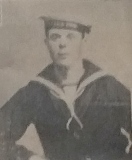
John Salsbury Burnnand, Master, Mercantile Marine. John was born at Brixham, Devon in 1864, the son of William Millman Burnnand, and of Sarah Burnnand (nee Dymond). He married Mary Salter in Devon in 1891, and the couple raised four children. John was a long serving Merchant Mariner, and had worked for the Great Western Railway for over twenty years prior to the outbreak of the Great War. John was by then Master of Great Western Railway Depot at Goodwick. He died aboard ship at Boulogne Harbour on 13 April 1915, aged 50. Little more is known of John, as he is not commemorated by the CWGC.
Peter Vaughan Clay, Second Mate, Mercantile Marine. Peter was born at Fishguard, the husband of Esther Clay (nee George), of Gate House, High Street. He served in the Mercantile Marine, as Second Mate aboard the S.S. ‘Sonnie’, (London). On 11 August 1917, the Sonnie was torpedoed and sank by a German U-Boat, and Peter drowned. He was 61 years old, and is commemorated on the Tower Hill Memorial, London.
Gwynne Havard Davies, Private, STK/1431, Royal Fusiliers. Gwyn was born in Newport, the son of Evan and Maria Jemima Davies. The family later resided at Gorlan, Fishguard. He enlisted at Cardiff into the army, and was posted to the 10th Battalion, Royal Fusiliers, who were attached to 11 Brigade, 37th Division. The Division fought at the diversionary attack on Gommecourt during July 1916 and then at the Battle of the Ancre. After spending the Winter on the Somme, they moved North to Arras, and fought in the Battle of the Scarpe, where they took the strongly defended town of Monchy-le-Preux. Gwyn was Killed in Action during the Battle, on 11 April 1917, and is commemorated on the Arras Memorial, France.
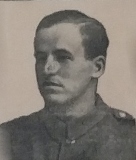
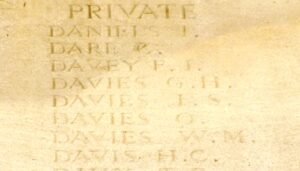
John James Davies, Able Seaman, Z/ 1889, Royal Naval Volunteer Reserve. John was born on 19 September 1879, the son of Thomas Davies, of Casnewydd, Goodwick. He enlisted into the Royal Naval Volunteer Reserve, serving aboard the SS Baron Jedburgh. The ship was at Canada when John was taken ill. He Died on 21 October 1918, aged 39. He is buried in Sydney (Harwood Hill) Cemetery, Canada.
William John Davies, Deck Hand, 15108DA, Royal Navy. William was born at Fishguard on 31 October 1889, the son of John and Martha Davies, of Sea View, Penwallis. He served in the Royal Naval Reserve, aboard HM Trawler Gambri. The Gambri was lost with all hands off the British Isles on 18 January 1918, and aboard her was William, who was 28 years old. He is commemorated on the Plymouth Naval Memorial, Devon.
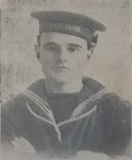
William Owen Davies, Sergeant, W/902, Royal Field Artillery. William was the son of Owen and Harriet Davies, of Fishguard. He enlisted at Haverfordwest into the Royal Field Artillery, and was sent to France where he was posted to ‘A’ Battery, 122nd Brigade, Royal Field Artillery, which was attached to the 38th (Welsh) Division. William came through the bloodbath of Mametz Wood unscathed, unlike many others of the Division, and the Division was sent North to Ypres to take part in the Passchendaele Offensive. William was Killed in Action during the build up to the Battle of Pilckem Ridge, on 27 July 1917, aged 28, and is buried at Canada Farm Cemetery, Belgium.
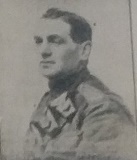
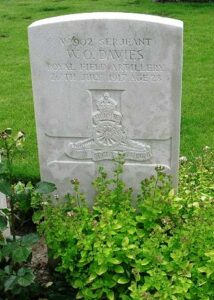
Harry Howard Dyke, Private, 7388, Devonshire Regiment. Harry was the son of Henry and Sarah Dyke, of Serlo Road, Gloucester. He married in 1909, and resided with his wife Isabella Dyke, at 5, Bearland Villas, Gloucester. Harry then joined the Fishguard Postal Staff prior to the war. He was probably an army reservist, and enlisted at Gloucester at the outbreak of war into the 1st Battalion, Devonshire Regiment, which was attached to 8 Brigade, 3rd Division. Harry landed in France with the battalion on 22 August 1914. The complete Division then moved to the Belgian frontier, and fought during the opening Battle of Mons, and in the epic retreat south to the Marne, where the German Offensive was stopped. They followed the German withdrawal to the Aisne, where they met them in battle, and stopped the advance on Paris. The Division then moved north to Flanders, and took part in the Battle of La Bassée, and at the Battle of Messines, which were a prelude to the First Battle of Ypres. Harry was killed in action here on 17 October 1914, aged 29. He has no known grave, and is commemorated on the Le Touret Memorial, Richebourg L’Avoue, France.
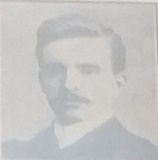
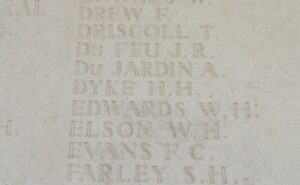
Eric Adrian Ellen, Captain, East Lancashire Regiment. Eric was born on 12 September 1892, the son of Edward Theodosius Ellen, and of Laura Ellen, of Erith. He enlisted into the Artists Rifles on 7 August 1914, and served on the Western Front from November onwards. He was commissioned in June 1915 into the 2nd Battalion, East Lancashire Regiment, and was posted to the battalion in France, where it was attached to 24 Brigade, 8th Division. Eric married Molly O’Grady at Wandsworth in 1916 whilst home on leave. He rejoined the battalion by the time of the Somme Offensive, which was launched on 1 July 1916. The Division fought on the Somme throughout July 1916, and remained there throughout the bleak winter of 1916/1917, stationed around the Somme Canal area. Eric was Killed in Action at Maurepas on 30 January 1917, and is buried at Hem Farm Military Cemetery, Hem-Monacu, France.
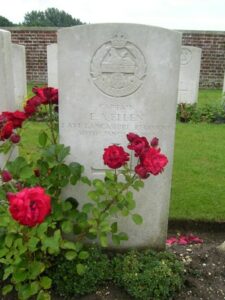
David Albert Evans, Private, 49014, Welsh Regiment. David was born at Cilgerran, the Son of Enoch and Letitia Evans, of Plain, Kilgerran, but resided and enlisted in Fishguard. He served in the 3rd Battalion, Welsh Regiment, a Home Service Battalion, which remained in the UK for the duration of the War. David became ill with pneumonia while stationed at Rhyl, and died on 14 February 1917. He was buried in Cilgerran (St. Llawddog) Churchyard. His brother, James Samuel Evans, was killed at Loos in September 1915.
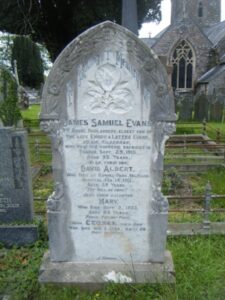
Edgar Evans, Private, 54514, Welsh Regiment. Edgar was born at Mathry in 1886, the son of James and Theodosia Evans. He was a farm labourer at Fishguard prior to the war, and had married Phoebe, of Cambrian Inn, Fishguard. Edgar enlisted at Fishguard into the army, and was posted to the 19th Battalion, Welsh Regiment, the Pioneer Battalion of the 38th (Welsh) Division. The Division arrived in France at the end of November 1915 and was stationed around Armentieres, before moving South to the Somme in June 1916. They famously captured Mametz Wood during July 1916 and suffered terrible casualties, which necessitated them being removed from the Battle and sent North to Ypres to recover. Edgar was mortally wounded at Ypres, and was brought to No. 46 Casualty Clearing Station at Mendinghem, where he Died of Wounds on 25 May 1917, aged 30. He is buried in Mendinghem Military Cemetery, Belgium.
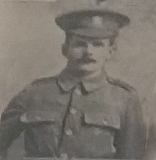
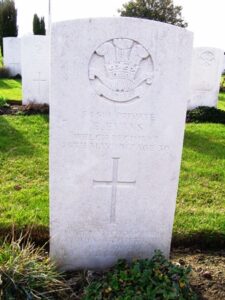
Edwin Evans, Gunner, 725752, Royal Field Artillery. Edwin was born in Mathry, the son of William and Maria Evans. The family later resided at 5, Vergam Terrace, Fishguard. He enlisted at Carmarthen into the Royal Field Artillery, and was posted into ‘B’ Battery, 98th Brigade, Royal Field Artillery, which was attached to the 22nd Division. The Division was in France during September, 1915 but were soon to embark at Marseilles for Salonika, arriving by 13 December 1915. They remained there for the duration of the War, and Edwin Died there of sickness on 19 October 1917, aged just 23. He is buried in Mikra British Cemetery, Kalamaria, Salonika.
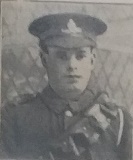
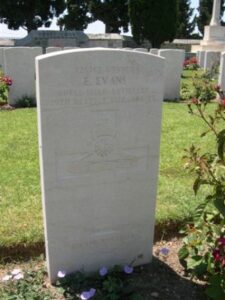
James Harries Evans, Private, 9882, Royal Fusiliers. James was born in Mathry, the son of John and M. M. Evans, later of Drim, Goodwick. He enlisted at Fishguard into the army, and was posted to the 13th Battalion, Royal Fusiliers, part of 111 Brigade, 37th Division. The Division fought at Gommecourt and the Ancre during the Somme offensive, before moving to Arras, where they took the village of Monchy-le-Preux. It was during the Second Battle of the Scarpe that James was Killed in Action, on 25 April 1917, aged just 21. He is commemorated on the Arras Memorial, France.
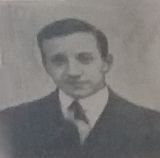
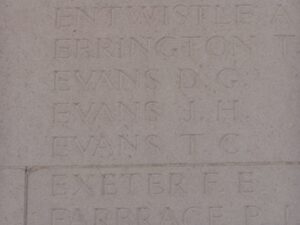
John Martin Fitzmaurice, Private, 13856, King’s Shropshire Light Infantry. John was born in Birmingham on 10 October 1888, the son of Edward and Ellen Fitzmaurice. Edward worked for the GWR, and had moved with Ellen to 37, New Park St., Castlefields, Shrewsbury after 1901. John followed in his fathers footsteps, working for the GWR at Fishguard Harbour for several years prior to the war, and lodged with his sister Mary and her husband Frederick Charles Webb at 17, Heol Dyfed. John had possibly been a reservist with the Welsh Regiment, but had enlisted at Shrewsbury into the 1st Battalion, King’s Shropshire Light Infantry. The battalion was attached to 16 Brigade, 6th Division, and moved to France on 10 September 1914, and had reinforced the BEF on the Aisne, before moving to Flanders. Here they took part in the Action of Hooge during June, 1915, and in 1916 moved to the Somme, where the Division fought at the Battle of Flers-Courcelette, the Battle of Morval and the Battle of Le Transloy. The following year saw them at Loos, where they fought at the Battle of Hill 70. John was killed here on 26 April 1917, aged 28. He is buried at Vermelles British Cemetery, France.
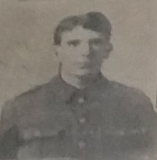
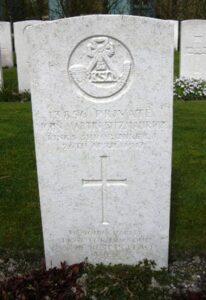
Rhys Edward Francis, Third Engineer, Mercantile Marine. Rhys was born at Merthyr Tydfil, the son of John and Elizabeth Francis. He moved to Fishguard where he married Mary Francis (nee Miles), of Awelfan, Fishguard. Rhys served in the Mercantile Marine as Third Engineer aboard the S.S. Paddington, a London registered cargo steamer. On 21 July 1917, Paddington was on voyage from Cartagena to Britain with Admiralty cargo and passengers, when she was torpedoed and sunk by the German submarine U-96, 250 miles west of Fastnet, with the loss of 29 lives. Rhys was 26 years old when he died that day, and is commemorated on the Tower Hill Memorial, London.
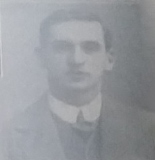
Thomas Garnon, Carpenter, Mercantile Marine. Thomas was born on 9 June 1893, the son of Joseph and Margaret Garnon, of 14, Victoria Avenue, Fishguard. He worked for the GWR at Goodwick prior to the war and enlisted on 7 July 1915 into the Royal Naval Volunteer Reserve. After training he was posted to the Grand Fleet, but became ill soon afterwards, and after a spell at the Haslar Royal Naval Hospital, was discharged as medically unfit on 6 July 1916. Thomas then volunteered to serve with the Mercantile Marine, and was posted aboard the S.S. Indore. He became ill and died of pneumonia at Durban on 7 August 1917, aged 23. Nothing more is known of him as he is not commemorated by the CWGC due to not being a casualty of war.
David William Griffiths, Private, 33986, South Wales Borderers. David was born in Fishguard in 1885, the son of William and Mary Griffiths. He enlisted at Haverfordwest on 17 August 1914 into the South Wales Borderers, and was posted to the 4th Battalion, South Wales Borderers. David served with the battalion at Gallipoli from 10 July 1915, where it was attached to 40 Brigade, 13th (Western) Division. David was shot in the hand at Gallipoli.and was evacuated off the peninsula for treatment. After recovering David was transferred to the 1st Garrison Battalion, Royal Welsh Fusiliers. On 20 December 1916 he was posted to France, joining the BEF, and transferred to the 14th Battalion, Royal Welsh Fusiliers, which was at Ypres, attached to 113 Brigade, 38th (Welsh) Division. The Division had moved there from the Somme in the summer of 1916, taking up positions at Boesinghe, along the Yser Canal. On 31 July 1917 the Division took part in the Passchendaele Offensive, capturing the strongly fortified Pilckem Ridge, before taking part in the Battle of Langemarck. David was badly wounded there by shell fragments, and was sent to the 47th Casualty Clearing Station at Dozinghem, where he Died of Wounds on 30 August 1917, aged 32. He is buried there, at Dozinghem Military Cemetery, Belgium.
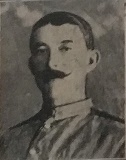
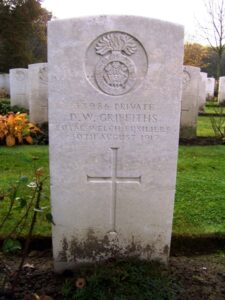
Thomas Owen Harries, Private, 1955, Australian Infantry. Thomas was born at Fishguard in 1893, the son of Mrs. Winifred Harries, 63, High Street, Fishguard. He emigrated to Australia in 1913, working as a Farmer, and enlisted there at Liverpool, New South Wales on 23 January 1915. He joined the 5th Reinforcements for the 13th Battalion, which embarked at Sydney aboard HMAT Kyarra on 13 April 1915 bound for Gallipoli via Egypt. Thomas joined the Battalion on Gallipoli on 13 July 1915, and was badly wounded at the Battle of the Nek on 9 August 1915. A Hospital Ship brought him, along with many others, back to Lemnos to the Army Hospital, but he Died of Wounds there on 23 August 1915 aged 22. He is buried in Portianos Military Cemetery, Lemnos.
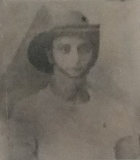
Graham Howells, Gunner, 371373, Royal Garrison Artillery. Graham was born at 1893, the son of David and Margaret Howells, of Ropewalk, Fishguard. He enlisted at Fishguard into the 171st Siege Battery, Royal Garrison Artillery, which formed part of the British forces in Italy. Graham was Killed in Action on 3 September 1918, aged 23, and is buried in Barenthal Military Cemetery, Italy.
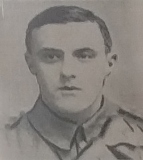
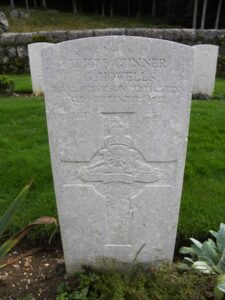
John Howells, Gunner, 7305, Royal Field Artillery. John was born at Fishguard, and enlisted at Glasgow into the Royal Field Artillery. He was posted into ‘A’ Battery, 85th Brigade, Royal Field Artillery, part of the 18th Division, which landed at Boulogne on 25 May 1915. They were heavily involved during the Battle of the Somme, and John was Killed in Action during the Battle of the Ancre, on 16 November 1916. He is buried at Lonsdale Cemetery, Authille, France.
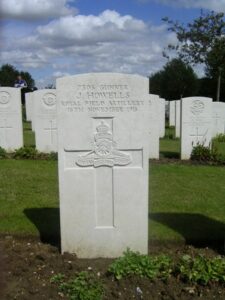
David Bevan Jenkins, Fireman, Mercantile Marine. David was born in Fishguard, the son of William Stephen Jenkins and Margaret Jenkins, of The Cottage, Fishguard. He served in the Mercantile Marine, as Fireman aboard the S.S. “Franz Fischer” (London). The Franz Fischer was attacked by a German Zeppelin on 1 February 1916, and David was Killed in Action during the attack, age 27. He is commemorated on the Tower Hill Memorial, London.
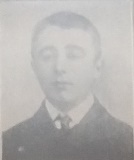
Frederick Clifford Jenkins, Boy, J/27364, Royal Navy. Frederick was born on 15 June 1898, the son of William S. Jenkins, J.P., and Margaret Jenkins, of The Cottage, Fishguard. He enlisted into the Royal Navy, serving aboard H.M.S. Viknor, an armed merchant cruiser of the 10th Cruiser Squadron. On 13 January 1915, while on active service in the North Sea, she struck a mine off Tory Island and sank with the loss of all hands. Frederick was just 19 years old, and is commemorated on the Portsmouth Naval Memorial, Hampshire.
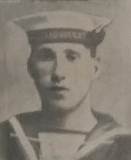
William John, Sapper, 63065, Royal Engineers. William was the husband of Margaret John (nee Owen), of Glyn-y-Mel Road, Lower Town, Fishguard. He enlisted into the Royal Engineers on 6 March 1915 and was posted to North Wales to join the 38th Signal Company, which was attached to the 38th (Welsh) Division. The division moved to Winchester soon after William joined his unit, and it began training as a complete unit in preparation for its move to France in December 1915. On 17 September 1915 William was among a large number of men inoculated for typhoid, but within days he began to suffer from some sort of reaction and was hospitalised. He was finally discharged from the army as medically unfit on 10 May 1916, suffering from breathlessness and heart problems. He returned to Fishguard where he died on 6 May 1917, aged 31. Nothing more is presently known of William, as he is not commemorated by the CWGC, so further research is ongoing.
Cecil Hugh Jones, Captain, Royal Welsh Fusiliers. Cecil was the eldest son of Sir Evan Davies Jones, Bart., and Cecilia Anne Jones, of Pentower, Fishguard. He was J.P. for the County of Pembroke, barrister of the Inner Temple, and M.A. of Cambridge. Cecil was commissioned into the 11th Battalion, Royal Welsh Fusiliers, part of 67 Brigade, 22nd Division, which moved to France in September 1915, but was promptly sent to Marseilles, and embarked for Salonika, arriving in late November 1915. The Division stayed there for the duration of the war, and it was at Salonika, during the Battle of Doiran, that Cecil was Killed in Action on 18 September 1918, aged 31. He is buried at Doiran Military Cemetery, Salonika. Many thanks to Dean Freeman for the photograph.
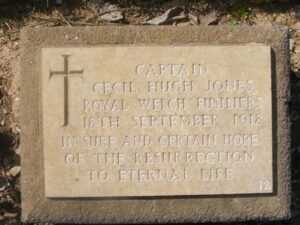
Samuel George Jones, Private, M2/121139, Army Service Corps. Samuel was born in 1889, the son of Thomas and Martha Jones, of 73, High Street, Fishguard. He was a fitter at Fishguard prior to the war, and enlisted at Goodwick on 3 September 1915 into the Army Service Corps. Samuel embarked at Devonport on 7 November 1915 aboard SS Anchises, and after disembarking at Alexandria three days later, was posted to the 569th Mechanical Transport Company, Army Service Corps. The following month the Company sailed for Basra. Samuel then served in the Mesopotamian Campaign, and died of cholera in Mesopotamia on 16 June 1916. He is buried in Basra War Cemetery, Iraq.
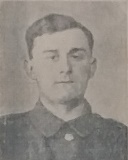
David Lewis, Gunner, 667, Royal Garrison Artillery. David was born at Pembroke, the son of Lewis Lewis and Phoebe Lewis. The family moved to Whitland where David was brought up, but he then married Mary Lewis, of Bridge Street, Lower Fishguard, and lived at Fishguard prior to the outbreak of War. He enlisted at Fishguard into the 114th Siege Battery, Royal Garrison Artillery, and served on the Western Front. David was Killed in Action aged 31, on 5 August 1917. He is buried on the Somme, at Peronne Road Cemetery, Maricourt, France.
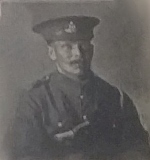
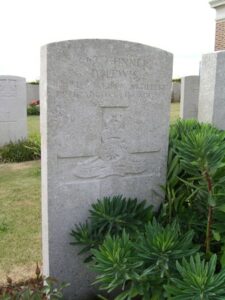
Thomas Lewis, Private, 26809, Welsh Regiment. Thomas was born at Fishguard, and enlisted at Bridgend into the army. He was posted to the 9th Battalion, Welsh Regiment, which was attached to 58 Brigade, 19th (Western) Division. The Division crossed to France during July 1915, and saw it’s first action at The Battle of Loos, during December 1915. They played an important part in the opening of the Battle of the Somme, by taking Ovillers village, and fought through the Somme offensive, until moving North to Ypres in 1917. At Ypres, the Division fought at the Battle of Messines, and it was here that Thomas was Killed in Action on 19 July 1917. He is commemorated on the Ypres (Menin Gate) Memorial, Belgium.
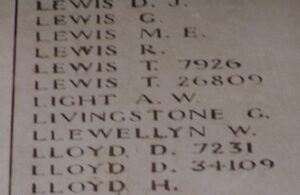
W. P. Lewis, Cannot be identified.
William George Mathias, Guardsman, 1210, Welsh Guards. William was born at Letterston in 1885, the son of John and Sarah Mathias. The family moved to Gilshave, Fishguard prior to the war, and William enlisted at Bridgend into the 1st Battalion, Welsh Guards. The battalion had been formed after the Royal Warrant of 26 February 1915, and joined the 3rd Guards Brigade, Guards Division in France during the summer. They saw their first major action during the Battle of Loos in September 1915. William did not make it to France though, as he died at Caterham Military Hospital, Surrey on 20 May 1915, aged 30. William is buried in Fishguard (Hermon) Baptist Burial Ground.
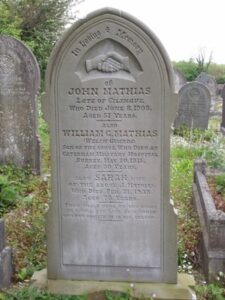
George Durrant Morgan, Lance Corporal, 9458, Welsh Regiment. George was born at Swansea in 1878, the son of George Luce and Elizabeth Morgan. He married Florence Herbert, of Crumlin, at Fishguard in 1909 and the couple lived at Murton House, Dyffryn, Goodwick, where George worked as a postman. George enlisted at the outbreak of war at Swansea, into the 2nd Battalion, Welsh Regiment, which was attached to 3 Brigade, 1st Division. The Division had been one of the first to arrive in France, fighting at the Battle of Mons, and taking part in the retreat to the Marne, where the Germans were stopped. They then fought at the Aisne, and at Chivy, before being moved north to Ypres. Here they fought at the First Battle of Ypres. George was killed in action at Ypres, during the epic stand of the 2nd Welsh at the Battle of Gheluveldt, on 25 October 1914. He was 36 years old, and is commemorated on the Ypres (Menin Gate) Memorial, Belgium.
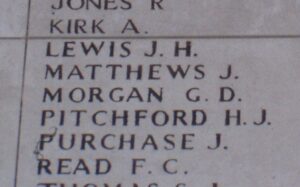
Henry Morley. Henry cannot presently be identified.
John James Morris, Bombardier, 371094, Royal Garrison Artillery. John was born in Fishguard in 1896, the first son of Benjamin and Martha Morris of 8, Wallis Street, Fishguard. John enlisted at Fishguard into the Pembrokeshire Battery, Royal Garrison Artillery, and was posted to the 16th Heavy Battery, which was attached to the 16th (Irish) Division. The Division concentrated around Bethune, and served at the Battle of the Somme from July 1916 until moving North to Ypres, where they fought at the Battle of Passchendaele. John was Killed in Action aged 21 on 11 September 1917 alongside two other men of his Gun Battery. He is buried in Bard Cottage Cemetery, Belgium.
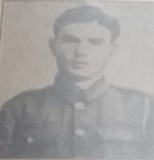
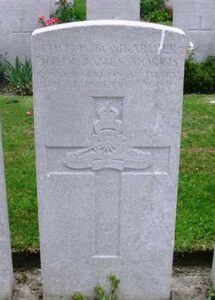
Albert Ernest Owen, Private, 53918, Welsh Regiment. Albert was the Son of James and Mary Owen, of Marloes. He was the manager of the Star Tea Company at Fishguard prior to the war, and enlisted into the 15th Battalion, Welsh Regiment, known as the Carmarthen Pals battalion, which was attached to 114 Brigade, 38th (Welsh) Division. The Division had landed in France during December 1915 and had spent their first winter in the trenches near Armentieres. In June they marched south to the Somme, where they were tasked with the capture of Mametz Wood. The attack on the wood began on 7 July 1916, but met with fierce resistance, and it took until 12 July to clear the wood. The Division suffered terrible casualties at Mametz, and were taken out of the line, and moved to Ypres to rebuild. Albert was wounded at Ypres, and died on the 30 April 1917. He was 30 years old, and is buried at Ferme-Olivier Cemetery, Belgium.
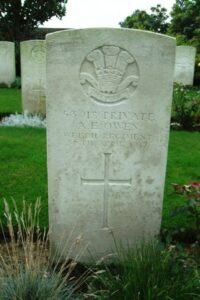
Norman Howell Owen, Captain, Royal Army Service Corps. Norman was Son of John Morgan Owen, and Margaret Elizabeth Owen. He had been born in Fishguard in 1888, and was raised there, at Brynymor, Fishguard. Norman was commissioned into the Army Service Corps on 8 February 1915. Little else is presently known of Norman, but by the end of the war he had made his way up through the ranks to Captain. He died at Broadway Miltary Hospital, Sheerness, Kent on 1 March 1919, aged 31. Norman is buried in Fishguard Church Cemetery. His father was by now widowed, and resided at The Grange, Wooden, Saundersfoot.
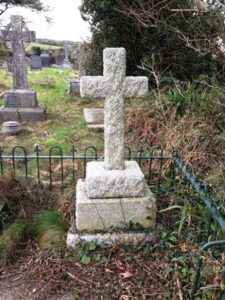
James John Phillips, Private, 3804, Welsh Regiment. James was the son of William and Sarah Phillips, of Bwlch-Y-Rhos, Goodwick. He married Edith Tegan early in 1914, and the couple briefly set up home at 5, Jubilee Terrace, Wallis, Fishguard, Pembrokeshire. At the outbreak of war, James enlisted at Fishguard into the 1/6th Battalion, Welsh Regiment. The battalion was one of the first territorial units to move to France in August 1914. Initially, in late 1914 and early 1915, they were on lines of communication and in July 1915 were based in the Locre and Kemmel area, facing the Germans who were on the high ground at Spanbroekmolen. The battalion was in the trenches, but also doing work repairing trenches etc. On 5 July 1915 the battalion was attached to 84 Brigade, 28th Division, and took part in the Battle of Loos. On 23 October 1915 the battalion was transferred to 3 Brigade, 1st Division, becoming the Divisional Pioneer Battalion on 15 May 1916, before moving to the Somme, where they fought throughout the whole battle. James was killed in action during the latter stages of the offensive, on 31 December 1916, aged 23. He is buried in Warlencourt British Cemetery, France.
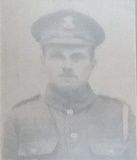
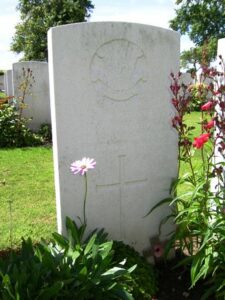
William Mathias Richards, Pioneer, 130559, Royal Engineers. William was born at Mathry on 21 November 1881, the son of Joseph and Hannah Richards. The family later resided at Fishguard, but William married, and lived with his wife Hannah Richards, at 27, Cranbury Avenue, Southampton. William enlisted ‘In the Field’, into the South Wales Borderers, but was transferred into the Royal Engineers, serving in ‘F’ Special Company. The Special Companies were Chemical Warfare Engineers, which handled Gas Shells to be fired from Stokes Mortars. William was Killed in Action on 6 April 1917, during the build up to the Battle of Vimy Ridge, part of the main Battle of Arras, while his Company were situated in the Souchez Valley. He was aged 36, and is buried in Zoave Valley Cemetery, Souchez, France.
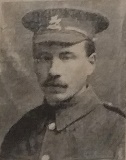
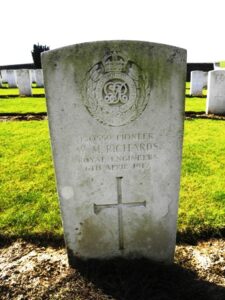
Edgar Llewellyn Roberts, Private, 1271, Guards Machine Gun Regiment. Edgar was born in Fishguard, the son of Llewellyn and Hannah Roberts, of Anchor House, Fishguard. He enlisted at Fishguard into the Welsh Guards, and served with the 1st Battalion, Welsh Guards in France from May 1915 onwards, seeing action at Loos, the Somme, and at Passchendaele. On 1 March 1918 the Guards Division formed four Machine-Gun Companies, which were then reformed by Royal Warrant into the Guards Machine Gun Regiment on 10 May 1918. Edgar was transferred from the Welsh Guards into the 5th Battalion, Guards Machine Gun Regiment, but was seriously wounded not long after. He died of wounds at Northampton on 14 May 1918, aged 28 and is buried at Fishguard (Tabernacle) Congregational Chapelyard.
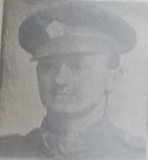
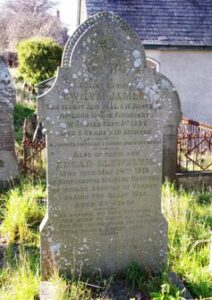
Thomas H. Roberts, Private, 5896, Leinster Regiment. Thomas was born at Fishguard, and enlisted at Haverfordwest into the Royal Army Service Corps. He transferred into the 1st Battalion, Leinster Regiment (Royal Canadians), part of 29 Brigade, 10th (Irish) Division. The Division fought at Gallipoli, before being evacuated to Salonika where they spent 11 months before returning to Egypt, and fighting in the Palestinian Campaign, where Thomas was mortally wounded. He Died of Wounds on 10 October 1918, and is buried at Alexandria (Hadra) War Memorial Cemetery, Egypt.
William Rowland Roberts, Lance Corporal, 72741, Sherwood Foresters. William was born in Scleddy on 17 March 1891, the son of William and Ann Roberts, of The Post Office, Dwrbach. He enlisted at Haverfordwest on 27 January 1915 into the Army Service Corps, but later transferred into the 2nd Battalion, Sherwood Foresters (Notts and Derby Regiment), part of 71 Brigade, 6th Division, in November 1917. The Division fought at Hooge, and at the Somme, before fighting at Loos and the Battle of Cambrai, where William joined them. In Spring 1918 they were in Flanders, and fought in the Battles of Kemmel, where William was Killed in Action on 19 April 1918, aged 27. Due to the terrible conditions, and the ferocity of the fighting at the time, his body was lost, and so he is commemorated on the Tyne Cot Memorial, Zonnebeke, Belgium.
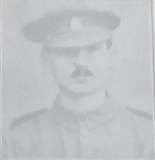
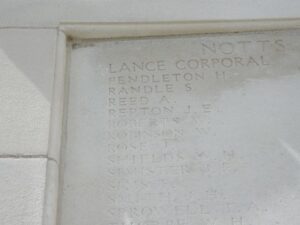
William John Slocombe, Master, Mercantile Marine. William was born at Swansea, the son of Agnes Slocombe and the late William Slocombe. He resided at Fishguard with his wife Margaret Slocombe (nee Houghton), who later moved to 65 Island Road, Garston, Liverpool. William was Master of the S.S. ‘Dartmoor’ (South Shields). The Dartmoor was a defensively armed ship, which was torpedoed by a German U-boat about 35 miles from Fastnet in the Atlantic on 17 May 1917, and sank with the loss of 25 crewmen, including William. They are commemorated together on the Tower Hill Memorial, London.
Albert Llewelyn Thomas, Sergeant, 3107, Life Guards. Albert was the son of William and Elizabeth Thomas, of Fishguard, and served in the 2nd Life Guards. The Life Guards were one of the elite Regiments in the British Army, and mobilised for war during August 1914, being attached to the 7th Cavalry Brigade, 3rd Cavalry Division in France. The Division landed at Zeebrugge during October 1914, fighting at Antwerp and First Ypres. During 1915 they fought at Second Ypres and at Loos, and in 1917 fought at Arras. They helped to push the German’s back in late 1918, ending up at Waterloo at the end of the War. Some of the men of the Regiment were then attached to the West African Frontier Force, and Albert was one of these. He was in Nigeria attached to the 4th West African Service Brigade when he Died on 11 January 1919. He is buried at Oshogbo Cemetery, Nigeria.
A. V. Thomas. This man is commemorated under the wrong name. See Aerthur Thomas Vittle.
James Thomas, Corporal, 79635, Royal Garrison Artillery. James was born at Fishguard in 1882, the son of Rosa Thomas. He resided at Abertillery prior to the war, and married Edith May Everson there on 11 June 1913. The family then moved to Cheltenham, where James worked as a Grocers Assistant. He enlisted there into the Royal Garrison Artillery on 12 May 1916. On 9 January 1917 James was posted to France with the 241st Siege Battery, Royal Garrison Artillery. The Battery was at Arras during the spring of 1917, and took part in the Battle of Arras. James was wounded there, before being brought back to the 19th Casualty Clearing Station at Etrun, where he Died of Wounds on 1 June 1917, aged 34. James is buried there at Duisans British Cemetery, Etrun, France.
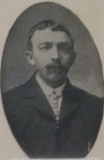
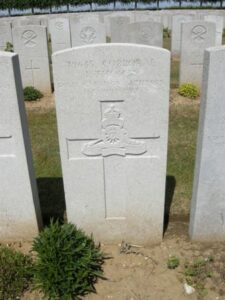
Joseph Henry Thomas, Private, 62360, Welsh Regiment. Joseph was born in 1888, the son of Lettice Thomas, of 15, Smyth Street, Fishguard. He enlisted there into the army on 23 February 1916, and was posted to France on 29 March 1918, where he joined the 9th Battalion, Welsh Regiment. The Battalion had been in France since July 1915, attached to 58 Brigade, 19th (Western) Division, and had taken part in the Battle of Loos in 1915, and the Battle of the Somme the following year. In the summer of 1917 the Division took part in the Battle of Messines, and the Battle of Passchendaele. On 21 March 1918 the Division was caught by the German Spring Offensive, and suffered terrible casualties over the coming days, before being withdrawn to Ploegsteert Wood to rebuild. However, a fresh attack hit them there, and the Division suffered terrible casualties in Flanders during the chaotic first few weeks of the attack. Joseph was Killed in Action in Flanders on 18 April 1918, aged 29, and is buried at Haringe (Bandaghem) Military Cemetery, Belgium.
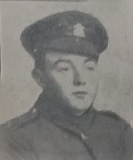
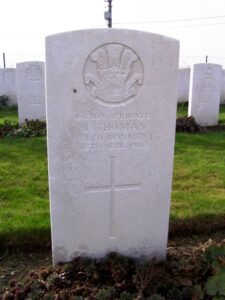
Morgan Thomas, Private, 307393, Sherwood Foresters. Morgan was born at Mathry in 1892, the son of John and Dorothy Thomas. After 1901 the family had moved to 22, Brodog Terrace, Fishguard. Morgan enlisted at Fishguard into the army, and was posted to the 2/8th Battalion, Sherwood Foresters (Nott’s and Derby Regiment), part of 176 Brigade, 59th Division. The Division were sent to Ireland in April 1916 to quash the rebellion there, before landing in France in February 1917. In France they followed the German withdrawal to the Hindenburg Line, before moving to Ypres, where they fought in the Battle of the Menin Road. The Division turned North, to take Polygon Wood, alongside the 4th Australian Division, and it was at Polygon Wood that Morgan was Killed in Action, on 26 September 1917, aged 25. He is commemorated on the Tyne Cot Memorial, Zonnebeke, Belgium.
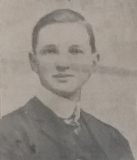
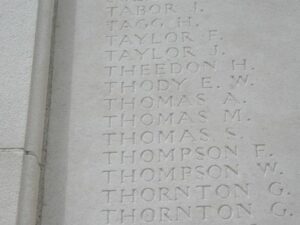
Duncan Edward Tozer, Stoker, 2927T, Royal Naval Reserve. Duncan was born at Torquay on 7 August 1885. He resided at Fishguard prior to the war, with his wife Nellie, and worked there for the Great Western Railway. Duncan enlisted into the Royal Naval Reserve, serving aboard HMS Defence. She was an armoured cruiser, which had been built at Pembroke Dockyard, and launched on 24 April 1907. She was stationed in the Mediterranean at the outbreak of War. Defence then became the flagship of the First Cruiser Squadron, commanded by Rear Admiral Sir Robert Arbuthnot, and took part in the Battle of Jutland. At Jutland, the Defence had badly damaged the German Cruiser Wiesbaden, and was closing in for the kill when she was hit by two salvoes from other German Cruisers nearby. She exploded and sank almost immediately with the loss of all hands, on 31 May 1915. One of these men was Duncan, and he is commemorated alongside his shipmates on the Plymouth Naval Memorial, Devon.
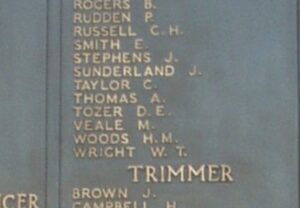
Ronald Claude Tozer, Private, 11410, Royal Welsh Fusiliers. Ronald was the brother of Duncan, and was also born at Torquay, and resided at Fishguard, where he worked as a Postman. Ronald enlisted at Wrexham on 4 April 1914 into the 2nd Battalion, Royal Welsh Fusiliers. On 11 August 1914, the Battalion landed at Rouen, attached to 19 Brigade, and fought at the Battle of Mons and the retreat to the Marne. After the successful British attack on the Aisne, the BEF was moved to positions east of Ypres. After fighting at First Ypres, the 2nd RWF moved to positions at La Cordonnerie, and this is where Ronald was Killed in Action, on 13 November 1914. He is buried in Pont-Du-Hem Military Cemetery, France.
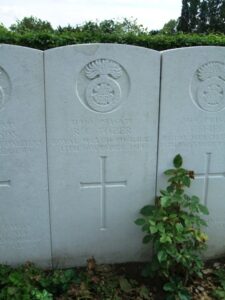
Arthur Thomas Vittle, Mess Room Steward, Mercantile Marine. Arthur was the illegitimate son of Griffith Thomas of Llanycefn and Catherine Vittle, of 23, Main Street, Fishguard. His parents married in 1903, and Arthur, although officially christened Arthur Vittle, went by the name of Arthur Vittle Thomas locally. He served with the Mercantile Marine aboard the S.S. Acadian, a Montreal registered cargo steamer. On 16 September 1918, Acadian was on voyage from Bilbao to Ayr with a cargo of iron ore, when she was torpedoed and sunk by the German submarine UB-117, with the loss of 25 lives. Arthur was 18 years old when he died that day, and is commemorated on the Tower Hill Memorial, London. Arthur is commemorated on the Fishguard memorial as A. V. Thomas. His father won the Military Medal whilst serving with the 10th Battalion, Devonshire Regiment in 1917.
Eric Alfred English Walker, Lieutenant, Royal Fusiliers. Eric was the Son of John George and Alice Walker, of 11, Broom Water, Teddington, Middx. Eric was commissioned into the Royal Fusiliers, and served with the 20th Battalion, which was attached to 98 Brigade, 33rd Division. In November, 1915 the Battalion landed in France, and subsequently transferred to 19 Brigade, 33rd Division. The Division moved into positions at the Somme, where they took part in the Battle of Albert, and the Battle of Bazentin, where they attacked High Wood. Eric was killed in action during the attack on High Wood on 22 August 1916. He was 24 years old, and is buried at Thistle Dump Cemetery, High Wood, Longueval, France.

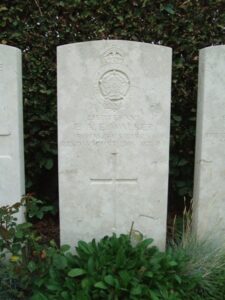
Joseph Waugh, Private, 55317, Royal Fusiliers. Joseph was born in Fishguard, the son of John and Mary Clara Ann Waugh, of Brig-y-Don, High Street, Fishguard. He enlisted at Fishguard into the Army Service Corps, then transferred into the 8th Battalion, Royal Fusiliers, which was attached to 36 Brigade, 12th (Eastern) Division. The Division moved to France at the end of May 1915, fighting at Ploegsteert and Loos that year. They fought on the Somme in 1916, before moving back to Arras, and fought in the Battle of Arras, at the Scarpe, where Joseph was Killed in Action, aged 24, on 3 May 1918. He is commemorated on the Arras Memorial, France.
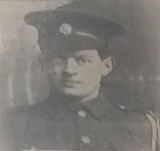
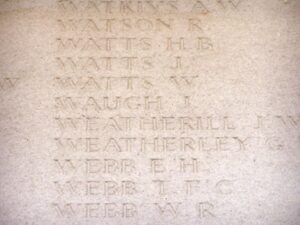
Henry Francis Wood, Private, 6610, Royal Berkshire Regiment. Henry was the second eldest of five children of Henry and Sophia Wood of Victoria Avenue, (latterly Brodog Terrace) Fishguard. The family had moved to the town from Wargrave near Maidenhead, Berkshire around 1910. Henry enlisted at Maidenhead into the 1st Battalion, Royal Berkshire Regiment prior to the war, and being a regular soldier moved to France with the battalion on 13 August 1914, attached to 6 Brigade, 2nd Division. One of the first Divisions to move to France, the 2nd Division fought at the Battle of Mons, and retreating southwards, fought at the Affair of Landrecies, the Rearguard Actions of Villers-Cotterets, and at the Battle of the Marne where the German offensive was stopped. The Germans retreated north, and the BEF met them, fighting at the Battle of the Aisne. The 2nd Division were then moved to Flanders, where they fought at the First Battle of Ypres, when the German sweep through Flanders was stopped. Henry was killed at Ypres on 30 October 1914. He was 31 years old, and is commemorated on the Ypres (Menin Gate) Memorial, Belgium. His brother Sidney George Wood also fell.
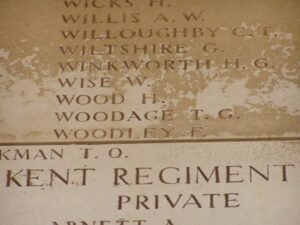
Sidney George Wood, Private, 11829, Welsh Regiment. Sidney was born at Frimley, Surrey and moved with his parents Henry and Sophia Wood, to 11, Victoria Avenue, Fishguard. He enlisted at Haverfordwest into the 8th Battalion, Welsh Regiment, which was the Pioneer Battalion to the 13th (Western) Division. The Division assembled on Salisbury Plain, and left Britain on 13 June 1915, bound for Gallipoli via Alexandria, and landed at Cape Helles on 6 July 1915. They transferred to ANZAC Cove on 3 August 1915, and fought in the Battle of Sari Bair. This is where Sidney was Killed in Action, aged 27, on 8 August 1915. He is commemorated on the Helles Memorial, Gallipoli. His brother Henry also fell.
Herbert Charles Wray, Private, 33799, Welsh Regiment. Herbert was born at Bollington, Hampshire, and resided at Fishguard prior to the War. He enlisted at Fishguard into the army, and was posted to the 9th Battalion, Welsh Regiment, which was attached to 58 Brigade, 19th (Western) Division. The Division saw its first major action during the Battle of Loos on 25 September 1916. They moved to the Somme early in 1916, where they took part in the assault on Ovillers-la-Boiselle on 1 July 1916. Herbert was Killed in Action at Ovillers, on the opening day of the Battle of the Somme, on 1 July 1916. He is commemorated on the Thiepval Memorial, France.
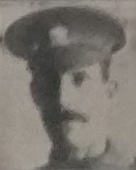
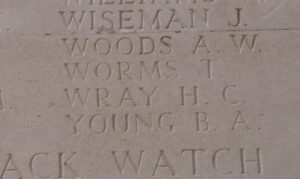
Fishguard War Memorial, World War Two, 1939-1945
Emlyn Owen Bevan, Able Seaman, D/SSX 17405, Royal Navy. Emlyn was the Son of Richard Edward and Margaret Bevan, Of Fishguard, and served in the Royal Navy, aboard HMS Ardent. Ardent was an ‘A’ Class Destroyer, which was commissioned on 14 April 1930. On the outbreak of war she joined the flotilla at Portland to guard the first troop convoys to France. She sailed for Liverpool in January 1940 and was deployed in the Irish Sea and the South Western Approaches. In April she was transferred to the Home Fleet, after the German invasion of Norway, to carry out convoy escort duties. On 31 May 1940, Ardent formed part of an escort force which accompanied the Aircraft Carriers HMS Ark Royal and HMS Glorious to the Norwegian Coast to carry out air operations in support of the withdrawing Allied forces from Norway. On 8 June, Ardent joined HMS Acasta in escorting HMS Glorious back to Scapa Flow, when the ships were discovered by the German Battlecruiser’s Scharnhorst and Gneisenau, and the Ardent and Acasta engaged the vastly superior German Battlecruiser’s to allow the Glorious to escape. Sadly the Acasta and Glorious were sunk in the following battle, and the Ardent capsized, with the loss of over 152 men. One of these was Emlyn Owen Bevan, who was killed in action during the Battle, on 8 June 1940. He was just 22 years old, and is remembered on the Plymouth Naval Memorial, Devon.
Sydney James Branchett, Civilian. Sydney was the Husband of Maude Emily Branchett, of 56 West Street, Fishguard. He died at 5, Powderham Terrace, Teignmouth, during an Air Raid on 10 January 1943. He was one of twenty people killed in the town during the raid that night. Sydney was 50 years old.
Tom Evans Brown, Trooper, 7962954, Royal Armoured Corps. Tom was the Son of James and Olwen Brown, of Fishguard, and served in the 12th (Prince of Wales’ Royal) Lancers. When war was declared, the 12th Lancers were based at Aldershot. They landed in France in October 1939 as part of the BEF, equipped with armoured cars. After being evacuated from Dunkirk, and losing their armoured cars in the process, the Regiment became the Reconnaissance Regiment for the 1st Armoured Division, and moved to Egypt in November 1941. The Regiment fought throughout the Western Desert campaign, and in September 1943 moved to Italy as part of the 1st Armoured Division. They fought in Italy until the end of the war. Tom was killed in action in Italy on 6 July 1944, aged 21, and is buried in Ancona War Cemetery, Italy.
Alwyn Durrant Cornock, Guardsman, 2738554, Welsh Guards. Alwyn was the Son of James and Eva Cornock, of Llanychaer, Pembrokeshire. He served with the 1st Battalion, Welsh Guards, which was part of the 32nd Guards Brigade, Guards Armoured Division. After landing in Normandy in June 1944, the Welsh Guards fought during the break out from the beach-head, and in the drive through France and Belgium. By September the Welsh guards were fighting around Brussels. Alwyn was killed just after the liberation of the City, on 9 September 1944. He was 19 years old, and is buried at Brussels Town Cemetery, Belgium.
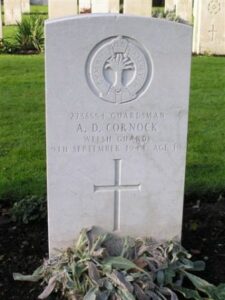
Hywel Davies, Mess Room Boy, Merchant Navy. Hywel was the Son of William and Maria Davies, of Llanelli, and resided in Fishguard, where he served aboard the S.S. St. Patrick (London). She was a Cross Channel ferry that worked the Fishguard to Rosslare route. In 1940 she was attacked by the Luftwaffe while on route, but escaped with no damage. On 13 June 1941 she had left Rosslare, and was passing Strumble Head when she was discovered by German Dive Bombers. The first clutch of bombs went straight through the bridge, and set the ships oil tanks on fire. She sank some time afterwards, with the loss of seventeen crew, a Gunner and twelve passengers. The remainder were rescued and landed at Milford Haven. Hywel died aboard the ship that day, aged just 18, and is remembered on the Tower Hill Memorial, London, and on his parents grave at Fishguard.
William Shatto Davies, Quartermaster, Merchant Navy. William was the Son of James Francis and Martha Jane Davies, and the Husband of Gertrude Davies, of Fishguard. He served in the Merchant Navy, aboard the S.S. St. Patrick (London), which was a Cross Channel ferry that worked the Fishguard to Rosslare route. In 1940 she was attacked by the Luftwaffe while on route, but escaped with no damage. On 13 June 1941 she had left Rosslare, and was passing Strumble Head when she was discovered by German Bombers. The first clutch of bombs went straight through the bridge, and set the ships oil tanks on fire. She sank some time afterwards, with the loss of seventeen crew, a Gunner and twelve passengers. The remainder were rescued and landed at Milford Haven. William was one of the unfortunate men who lost his life that day. He was 39 years old, and is remembered on the Tower Hill Memorial, London.
Oliver James Edwards, Mate, Merchant Navy. Oliver was the Son of Mr. And Mrs. D. Edwards, Of Newport, Pembrokeshire, and the Husband of Edith Mary Edwards, Of Fishguard. He served in the Merchant Navy, aboard the S.S. Greenawn (Goole). Greenawn was a cargo ship, which had set sail from London on 25 March 1941 bound for Invergordon. The ship went missing on the voyage, and was declared a ‘War Loss’ on 3 April 1941. Oliver disappeared with the ship on 3 April 1941. He was 37 years old, and is remembered on the Tower Hill Memorial, London.
John Henry Gillard, Greaser, Merchant Navy. John was the Husband of F. A. Gillard, of Boston, Lincolnshire. He served aboard the S.S. St. Patrick (London), which was a Cross Channel ferry that worked the Fishguard to Rosslare route. In 1940 she was attacked by the Luftwaffe while on route, but escaped with no damage. On 13 June 1941 she had left Rosslare, and was passing Strumble Head when she was discovered by German Dive Bombers. The first clutch of bombs went straight through the bridge, and set the ships oil tanks on fire. She sank some time afterwards, with the loss of seventeen crew, a Gunner and twelve passengers. The remainder were rescued and landed at Milford Haven. John was one of the unfortunate men who lost his life that day. He was 60 years old, and is remembered on the Tower Hill Memorial, London.
Clifford John Owen Griffiths, Petty Officer Stoker, D/KX80363, Royal Navy. Clifford was the Son of Mr. and Mrs. John Griffiths, and the husband of Betty Griffiths, of Trethomas, Monmouthshire. He served in the Royal Navy, aboard HMS Sultan I, which was the Shore Base for the Royal Navy at Singapore at the outbreak of war. Many of the crew of HMS Sultan were survivors of the Force Z catastrophe, the crews of HMS Repulse and HMS Prince of Wales. Clifford died on 24 December 1941 and was buried at sea. He was 29 years old, and is remembered on the Plymouth Naval Memorial, Devon.
Joseph Harvard, Master, Merchant Navy. Joseph was the Master of the S.S. Henri Mory (Swansea). Very little is known of Joseph, or of the ship, except that it was torpedoed and sunk by a German U-Boat on 26 April 1941. Joseph is remembered on the Tower Hill Memorial, London.
J. Hodges. Is commemorated on the War Memorial within St. Mary’s Church. He cannot be positively identified.
Oliver Paul Hodges, Assistant Steward, Merchant Navy. Oliver was the Son of Mr. and Mrs. William P. Hodges; husband of Hannah Hodges (nee Llewellyn). He served aboard the S.S. St. Patrick (London), and was killed aboard her on 13 June 1941 when she was sunk by a German Bomber. Oliver was 42 years old and is remembered on the Tower Hill Memorial, London.
John Emlyn Howells, Craftsman, 10579887, Royal Electrical and Mechanical Engineers. John was the Son of Mr. And Mrs. B. Howells, Of Fishguard. Nothing is yet known of his wartime service, except that he died on 2 March 1944, and is buried at Fishguard (Tabernacle) Congregational Chapelyard.
William Norton James, Sergeant (W.Op./Air Gnr.), 1338403, Royal Air Force Volunteer Reserve. William was the Son of William S. and Florence James, of Dinas Cross. He served in the RAFVR, with 61 Squadron, which was reformed in 1937 and attached to RAF Coastal Command. On 1 February 1944, the Squadron moved to RAF Coningsby, flying the Lancaster and attached to RAF Bomber Command. On the night of 30 March 1944 a massive formation of 795 RAF Bombers left Airfields around the UK, bound for Nuremberg. The German Fighter Command had forecast the route the bombers would take, and that night over 95 bombers were lost, the biggest loss of the war for Bomber Command. One of the Lancaster’s lost contained William, who was only 20 years old when his plane came down on the morning of 31 March 1944. He is buried alongside his crew in Heverlee War Cemetery, Belgium.
Archibald Jenkins, Gunner, 4205561, Royal Artillery. Archibald was the Son of David and Margaret Jenkins: Husband of Olivia Jenkins, Of Fishguard. He served in the Royal Artillery, with 116th Light Anti Aircraft Regiment. The Regiment was attached to the 53rd (Welsh) Division, and had landed as part of the reinforcing troops on Normandy at the end of June 1944. Archibald must have been wounded in Normandy, and returned home for treatment, and he died on 17 August 1944, aged 33. Archibald is buried at Fishguard (Hermon) Baptist Burial Ground.
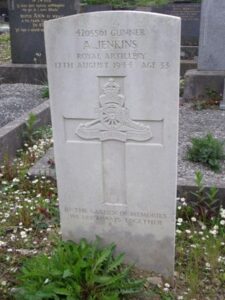
David Gwyn George Jenkins, Private, 5392152, Oxford and Bucks Light Infantry. David was the Son of David Gwynne Jenkins and Maud Jenkins, Of Fishguard. He served in the 7th Battalion, Ox & Bucks Light Infantry, which was part of the 167th Infantry Brigade which had fought in Tunisia, and had landed at Anzio during the invasion of Italy. David was killed in action in Italy on 25 September 1943. He was 26 years old, and is buried at Salerno War Cemetery, Italy.
Arthur Gwyn Jones, Flying Officer (Pilot), 169021, Royal Air Force Volunteer Reserve. Arthur was the son of Capt. Richard Thomas Jones and Margaret Jones, and the Husband of Menna Matthias Jones, of Fishguard. Arthur served prior to the war with the C.I.D., Special Branch, and volunteered for service in the Royal Air Force, training as a Pilot. Arthur became a flying instructor, and on 6 October 1944 was training a Sergeant Benyon in flying an Airspeed Oxford, Serial DF330, when the aircraft struck a tree while approaching the airfield, sending it crashing into a house. Arthur was 31 years old when he was killed in the crash, and is buried at Fishguard (Hermon) Baptist Burial Ground.
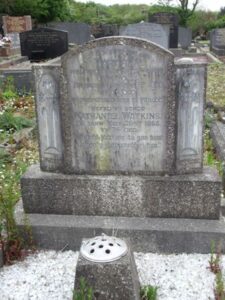
Daniel Morgan Rhys Jones, Captain, 67597, Royal Artillery. Daniel was the son of Owen Davies Jones and Mary Anne Jones, and the husband of Mary Jones, of East Croydon, Surrey. He served as Captain in the 445th Battery, 65th Field Regiment, Royal Artillery, which fought in the Western Desert during the Battle of El Alamein, attached to the 44th Division. They landed on Italy, and fought alongside the American 5th Army at Salerno, where Daniel was killed in action on 16 October 1943, aged 32. He is buried at Minturno War Cemetery, Italy.
Henry Howard Lewis, Ordinary Telegraphist, D/JX. 196384, Royal Navy. Henry was the son of William and Elinar Lewis, of Fishguard. He married Mair Evans, of Fishguard, in 1944. He served in the Royal Navy, aboard HMS Nighthawk, which was a Royal Naval base at Drem, Scotland. Henry died at Rochwood Hospital, Llandaff on 27 October 1945, aged 26. He is buried at Fishguard (Hermon) Baptist Burial Ground.
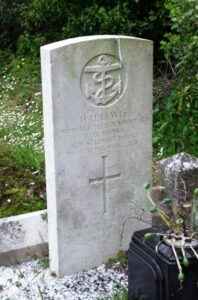
William Lewis, Cook, Merchant Navy. William was the Husband of Florence Anne Lewis, and served aboard the S.S. St. Patrick (London). He was killed when the Ferry was sunk by German Bombers on 13 June 1941 aged 61, and is remembered on the Tower Hill Memorial, London.
Wilkin Thomas Lewis, Boatswain, Merchant Navy. Wilkin was the Son of Thomas Davies Lewis, And of Ethel May Lewis of Fishguard. He served in the Merchant Navy, aboard S.S. Brandenburg (Leith). On 2 February 1941, Brandenburg left Gibraltar as part of Convoy HG-53, and gallantly stopped to pick up survivors of the torpedoed SS Courland on 9 February. The following day, she was herself torpedoed by the U-37, and sank with the loss of all bar one of the people on board. Wilkin went down with the ship on 10 February 1941. He was 28 years old, and is remembered on the Tower Hill Memorial, London.
Morgan Llewellyn, Cook, Merchant Navy. Morgan was the Son of Mary Jane Llewellyn, Of Fishguard, and the Husband of Nora Eleanor Llewellyn, Of Fishguard. He served in the Merchant Navy, aboard S.S. St. Andrew (London), which operated from Fishguard to Rosslare as a Passenger Ferry. During the evacuation of Dunkirk in 1940, all manner of ships were requisitioned, and used, one of which was the St. Andrew. She also served in the Landings at Anzio, where she suffered damage from German bombs while picking up survivors from the S.S. St. David. Morgan was probably injured in the bombing, and returned home, where he died on 25 July 1945, aged 42. He is buried at Fishguard Church Cemetery.
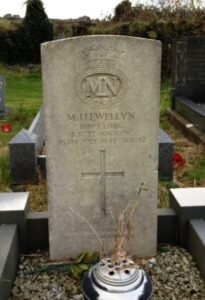
Thomas Evan Llewellyn, Greaser, Merchant Navy. Thomas was the Husband of M. Llewellyn, Of Fishguard, and possibly the father of Morgan above. He served aboard the S.S. St. David (London), which was a Passenger Ferry, used on the Fishguard to Rosslare route. Thomas was killed when the S.S. St. David, which was serving as a Hospital Ship, was bombed and sank off Anzio on 24 January 1944, with 224 people on board. Thomas was 62 years old, and is remembered on the Tower Hill Memorial, London.
Edward Henry Long, Civilian. Edward was the Husband of Phoebe Maud Long, of 1, Goodwick Bridge, Fishguard. He died at 32, High Street, Penge, in London when his street was struck by a German V1 ‘Doodlebug’ rocket on 18 June 1944. Edward was 48 years old.
James Harries Manning, Assistant Cook, Merchant Navy. James was the Son of Alfred and Martha Ann Manning, and the husband of Catherine Berry Manning, of Goodwick. He served as Cook aboard the Fishguard Ferry, SS St. Patrick. The St Patrick had left Rosslare for Fishguard early on the morning of 13 June 1941, and was about 12 miles from Strumble Head when she was attacked by German dive bombers. The first bomb struck her between the bridge and the funnel, penetrating the oil tanks and setting them on fire, sinking the ferry within an hour. The majority of the passengers and crew managed to get off the ship, and were rescued and brought to safety at Milford Haven, but James was one of seventeen who died that day. He was 34 years old, and is commemorated on the Tower Hill Memorial, London.
Percy George Miles, Aircraftman 1st Class, 927599, Royal Air Force Volunteer Reserve. Percy was the Son of George Henry and M. Miles, of Lower Town, Fishguard. He served with the RAFVR, but sadly little is known of him, except that he died on 6 July 1941, aged 21, and is remembered on the Runnymede Memorial.
David John Morris, D.S.C., Lieutenant, Royal Naval Reserve. David was the Son of Thomas and Ann Morris, and the Husband of Nancy Olwen Morris, Of Fishguard. He served in the RNR, at H.M.S. Baldur, which was the Royal Naval Base at Iceland. On 1 October 1943 David was gazetted with the Distinguished Service Cross, for ‘ courage and skill in many successful minesweeping operations in Mediterranean-waters, while serving in H.M. Ships Negro, Elbury, Achroite and Triton, and H.M. Motor-Minesweepers 47, 68, 80 and 171’. David was then posted to Baldur in Iceland, but sadly died there on 10 November 1944, aged 38. He is remembered on the Chatham Naval Memorial, Kent, and on the headstone of his wife’s parents at Hermon Baptist Chapelyard.
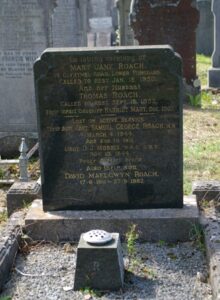
Richard John Nichols, Civilian. Richard was the Son of A. R. and S. B. Nichols, of Stratheden, West Street, Fishguard. He worked at Swansea Docks, and was mortally injured there during an air raid on 10 July 1940. Richard died the same day at Swansea Hospital, aged 23.
J. O’Sullivan. Is commemorated on the War Memorial within St. Mary’s Church. He cannot be positively identified.
Evan William Owens, Master, Merchant Navy. Evan was the Son of William and Emily Owens, and the Husband of Elizabeth Anne Esmond Owens, Of Fishguard. He was the Master of the Ferry S.S. St. David, which was requisitioned by the Admiralty at the outbreak of war. She served at Dunkirk, taking evacuees of the beach, and was then converted into a Hospital Ship. The St. David had sailed for many thousands of nautical miles, and had seen thousands of wounded soldiers treated aboard her, when she was sent to Anzio, as one of three Hospital Ships, to evacuate wounded soldiers off the beaches. She was attacked by a radio controlled German bomb on 21 January 1944, and sank within minutes, taking Evan with her. He was 49 years old, and is remembered on the Tower Hill Memorial, London. His gallant command of the ship during the war had seen Evan awarded the Lloyd’s War Medal for Bravery At Sea, and the King’s Commendation for Brave Conduct.
Stephen Phillips, Sailor, Merchant Navy. Stephen was the Son of Griffith and Phoebe Phillips, Of Lower Town, Fishguard. He served in the Merchant Navy, aboard S.S. Norman Monarch (Glasgow). The Norman Monarch had left Halifax, Nova Scotia on 10 May 1941, as part of Convoy HX-126, bound for Liverpool. Mid-way across the Atlantic the Convoy was sighted by a U-Boat Pack, and the Norman Monarch was torpedoed on 20 May 1941. The crew of the Norman Monarch were rescued by the S.S. Harpagus (London), but the Harpagus was to become another U-Boat victim that same day, and so Stephen was drowned during his second encounter with a U-Boat, on 20 May 1941, aged 24. He is remembered on the Tower Hill Memorial, London.
Samuel George Roach, Captain, Merchant Navy. Samuel was born in 1905, the son of Thomas and Mary Jane Roach, of 16, Glynymel Road, Lower Fishguard. He served as a Captain with the Merchant Navy. Samuel died at Lourenco Marques (Maputo, Mozambique) on 4 March 1944, aged 3, and is buried in Maputo Cemetery. No more is presently known about him, but he is commemorated on his parents grave at Fishguard (Hermon) Baptist Chapelyard.
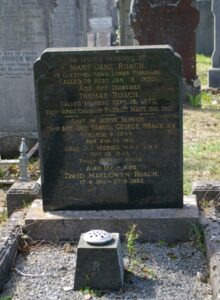
William Sydney Sedgeman, Sub Lieutenant, Royal Naval Reserve. William was the son of Elizabeth Ann Sedgeman, of Shirley House, Victoria Avenue, Fishguard. He served in the RNR, aboard HMS Vyner Brooke, which had been requisitioned by the Admiralty for troop carrying. When the Japanese invaded Singapore, Vyner Brooke was ordered from Singapore, carrying Nurses and evacuees. She sailed on the night of 12 February 1942, but on entering The Banka Straits was attacked by nine Japanese planes at 1pm. Vyner Brooke was hit repeatedly, with the Bridge being totally destroyed, and the steering gear out of order, so with the ship also on fire Captain Borton gave orders for the ship to be abandoned. In just over twenty minutes Vyner Brooke sank. Most of the survivors landed on a beach near Muntok where they set up a camp and commenced tending the wounded. A couple of days later, on 16 February 1942, they were discovered by a Japanese patrol which consisted of ten men and an Officer. Those that could walk, including William and Second Engineer J.J. Miller, were marched round a small headland lined up and shot, those who were lying wounded were bayoneted to death, only one survived the bayoneting. The nurses were then ordered to walk into the sea, on reaching waist height the Japanese commenced to machine gun them and all were killed save one. William was 27 years old, and is now remembered on the Singapore Memorial.
Benjamin George Stretch, Flight Sergeant (W.Op./Air Gnr.), 550584, Royal Air Force. Benjamin was the Son of Thomas George Stretch, And of Mary Stretch (Nee Protheroe), Of Fishguard. He served with 106 Squadron, RAF, which flew the Manchester Bomber for a short period at the start of 1942, but soon converted to Lancaster’s, flying as part of RAF Bomber Command. On the night of 15 October 1942 a large bomber force was ordered to bomb Cologne. The mission was a disaster, due to adverse weather conditions, and 18 aircraft were lost, including Benjamin’s aircraft, Lancaster W4302. He was 24 years old when his Lancaster crashed on the night of 15 October 1942, and is buried at Rheinberg War Cemetery, Kamp Lintfort, Nordrhein-Westfalen, Germany, alongside his fellow crew members.
Howard Garfield Sturgess, Petty Officer Supply, D/MX 67824, Royal Navy. Very little is known of Howard, but he served in the Royal Navy, aboard HMS Isis, which was an Intrepid Class Destroyer. Isis had served during the evacuation of the British from Greece in 1941, and sustained damage when hit by German Aircraft off Beirut, after the Battle of Crete. She had to be towed to Palestine for repairs, before seeing service during the Normandy Invasion in June 1944. The Isis was on patrol off the Western Sector, guarding the Normandy Invasion force when she struck a mine on 20 July 1944 and sank off Arromanches. Howard was one of the unfortunate men to die aboard her, and is remembered on the Plymouth Naval Memorial, Devon.
John Thomas, Sergeant, 1650201, Royal Air Force Volunteer Reserve. John was the Son of Charles Henry and Mary Anne Thomas, Of Fishguard. He served as a Navigator/ Bomber with 6 Operational Training Unit, Royal Air Force. On 1 November 1944 John was flying in an exercise aboard Vickers Wellington XII, Serial MP680, when it crashed near Silloth, Cumberland, killing all her crew. John was 22 years old when he died that day, and is buried at Fishguard (Hermon) Baptist Burial Ground.
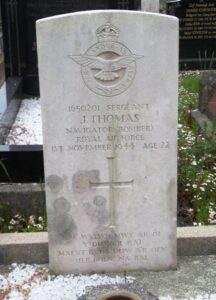
W. E. Thomas. Is commemorated on the War Memorial within St. Mary’s Church. He cannot be positively identified.
Cyril John Waters, Flight Sergeant (Air Bomber), 1419043, Royal Air Force Volunteer Reserve. Cyril was the son of Cyril and Anita Mary Waters, of Newport, Monmouthshire. He served as an Air Bomber with 57 Squadron, Royal Air Force, which was a heavy bomber unit, based at RAF East Kirkby. On 2 March 1945 Cyril was flying aboard Avro Lancaster III, Serial ND572 on a night training exercise when it collided with a Lancaster from 207, and crashed near Fen Farm, Ruskington, Lincolnshire, killing all of the crew. Cyril was 22 years old, and his body was brought home for burial at Fishguard Church Cemetery.
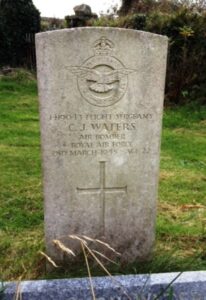
John Price Williams, Aircraftman 1st Class, Royal Air Force Volunteer Reserve. John was the Son of Henry and Eleanor Williams, Of Fishguard. He was recruited into the RAFVR, and embarked upon the troopship S.S. Anselm at Gourock, bound for Freetown. On 5 July 1941, Anselm was 300 miles north of the Azores, when she was spotted by the German Submarine U-96. She was torpedoed and sank within minutes, taking down 430 men, including 174 RAF personnel. One of these was John, and he is remembered on the Runnymede Memorial, Surrey.